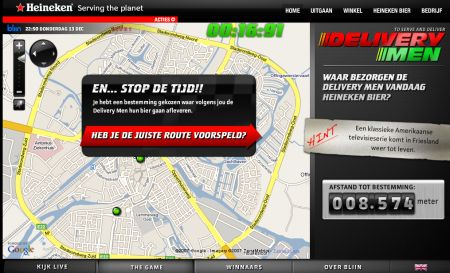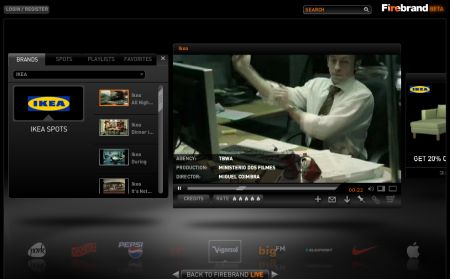von Roland Hachmann | Dez. 17, 2007 | Ad News, Blog, Digital Marketing, Marketing, Mobile Marketing, Online Advertising
Heineken in the Netherlands has launched a new advergame which looks interesting. The game asks playes to spot and track the delivery men of Heineken around the Netherlands and find out what their next stop will be. Whoever guesses correctly first, gets the chance to win a Nokia phone. So in a way, this game play is not that complicated or creative.

What I admire, is something completely different: Apparantly, these delivery men are tracked in real time with real journey data, during the regular working hours. And this is remarkable. I have also worked for clients with a huge fleet of delivery vehicles and I do appreciate the fact that Heineken managed to include their drivers into this game. Creatives usually come up easily with lots of brilliant ideas how to connect the mobile workforce of a client with a webpage via all sorts of mobile devices like phones or GPS tracking devices. But organisational reality most of the time kills these ideas.
So this won’t have been easy to push through the internal, most likely rather political, approval and commitment chain in order to get the buy in of all the different departments (marketing, distribution, logistics, etc.). Kudos, I like that.
(via)
von Roland Hachmann | Dez. 4, 2007 | Ad News, Blog, Digital Marketing, Marketing, Online Advertising
Mitch Joel blogs about advertising campaigns where the traditional campaign is long gone, but there still is a digital trail on YouTube and the likes, now leading to no longer existing microsites, etc.
In a traditional ad campaign, Marketers could get in and out in the span of a couple of weeks. Times have changed. The length of an ad campaign in the Digital Marketing space is dictated by the audience not by when the ad spend dies.
Interesting thought that has sparked a debate about purchasing the (digital) rights to media assets of integrated marketing campaigns. Here is my two cents which I put into Mitch’s comments:
Purchasing the rights to actors, directors, photography and such really depends on negotiations. I remember from my own experience that the guys at the classical advertising department were always shocked when they had to buy the rights for the internet, too. Because all of a sudden, they didn’t just buy the rights for, say, 1 year in Germany (in this case), but for world wide, because that is what the internet is: a medium that is globally accessible. It made each campaign relatively more expensive all of a sudden.
Just imagine what it will be like if they have to buy the rights not for Germany, and not for one year, but for worldwide, for ever!!
Advertisers won’t be able to not buy the digital rights. So the conclusion will have to be either: better rates in the contracts, or second rate actors, directors and photography. Not the most ideal setup.
von Roland Hachmann | Nov. 30, 2007 | Ad News, Blog, Digital Marketing, Marketing, Social Media Marketing
There is an interesting short post at one of the NY Times blogs about the evolution of beacon, Facebooks new project to include behaviour on third party sites within the news feed and profile. They show different types of popups of how Facebook alerted their users in a more or less obvious fashion about including third party information on their feed.
It started with a popup merely stating the fact, that the information will be passed on. Not reacting to it was assumed as approval. It disappeared after a short while and if you missed it, you „approved“ of the information transfer. Later versions included opt-outs, opt-ins, etc.
Facebook executives tell reporters that users who ignore the alert boxes will no longer be considered to have said “yes,†even after two days. If users ignore the alert box, Facebook says it will not post the news of their purchases to their friends. This is a big change, if implemented correctly. Users will still be hassled by the alert boxes from Facebook on its partner sites, but ideally they can ignore them now and not worry about their purchases being shared.
Facebook executives say they do not want to add a universal opt-out button because then users would not be able to try out Beacon on different sites to see what it can offer. One Facebook executive predicts that consumers may “fall in love†with Beacon once they understand it. Only time will tell.
A very broad prediction, which I don’t believe. But we’ll see.
It’s amazing that facebook started with such an opt-out clause – including the fact that you only had a few seconds to opt-out until the popup would disappear. Now I know that in the US, opt-out is legally viable, which it isn’t in Germany. Here in Germany, nobody would have even considered opt-out in the first place.
But that doesn’t make it an „American approach“ per se. I think, it rather looks like an amateurish approach to treat users in that way and I am not surprised that they changed it to the later versions. I would have assumed that they start with the opt-in approach right away, thinking user-centric instead of brand-centric. But hey.
von Roland Hachmann | Nov. 29, 2007 | Ad News, Blog, Digital Marketing, Marketing, Online Advertising
Firebrand now launched, and it has a wide selection of TV commercials online to watch. You can filter them by brand, animation, celebrity, etc. I particularly like the filter-selection „banned“, which could be quite promising in the future.
What I miss: you can’t comment on the ads. You can rate them, but not comment on them. Might be due to lack of editorial staff, and I hope that is the only reason. Because some say, it might be, because advertisers have expressed concerns about people commenting on ads.

One intelligent feature: as you can see on the screenshot above: offers of the advertisers can be integrated as clickable banners. Not sure if that always corresponds to what has been shown in the ad, but it would make sense.
So who will actually use this? Some people who seek entertainment? They would go to YouTube, wouldn’t they? And the ad folks? Only if this becomes more complete than other ad databases (including YouTube).
And what about including good print advertising?
von Roland Hachmann | Nov. 20, 2007 | Ad News, Blog, Digital Marketing, Marketing, Marketing Trends, Online Advertising, Social Media Marketing
Sofar, advertising on joost has only been in the form of short ads at the beginning or end of clips. Sort of like the traditional ad model.
Now we have the first attempt at actually providing added value through a marketing tactic. In this case, a widet:
On Thursday, Joost announced that Coca-Cola’s European division has created the first „commercial widget“ for the software. Called „Coke Bubbles,“ the downloadable advertising widget lets you choose a clip on Joost and then send it to fellow Joost users, appended with a note in the form of a „bubble.“
You can download it at „Coke Bubbles„. While I am unsure about whether this is a really clever idea, I do support the fact that Coke does not just run ads in the clips, but does try to provide added value. It’s a first step in the right direction.
A lot of marketing efforts will have to provide a clear added value in the future. Either through real product information at the points where consumers are seeking information. Or, alternatively, if consumers are not seeking product information, brands can help to provide plattforms, contents or tools for entertainment or networking – two of the other main things people seek out in digital media these days.
von Roland Hachmann | Nov. 19, 2007 | Blog, Digital Culture, Digital Marketing, Marketing
James Cherkoff tells us a nice little story about how tight marketing programs, the nice shop in a nice part of town, well trained sales people, the glossy leaflets and the good reputation of certain type of kitchen brand has been made obsolete by one single search on the web about what other customers of this brand had to say. The opinions were mostly negative and James ended up cancelling his order.
Of course, you would always have consulted other sources – most of all your closest peers – about opinions on any high involvement product or service. But the chances that you find many sources with the same brand of kitchen (car, dishwasher, etc.) in your closest range of peers was and is rather limited.
With todays possibilities to find opinions on anything on the web (even stuff you didn’t want to know about), it is ever more important for brands to keep their promises. People are fearing the moment of the totally transparent consumer, but hey, brands already face this complete transparency!



 Wo ich sonst so bin...
Wo ich sonst so bin...